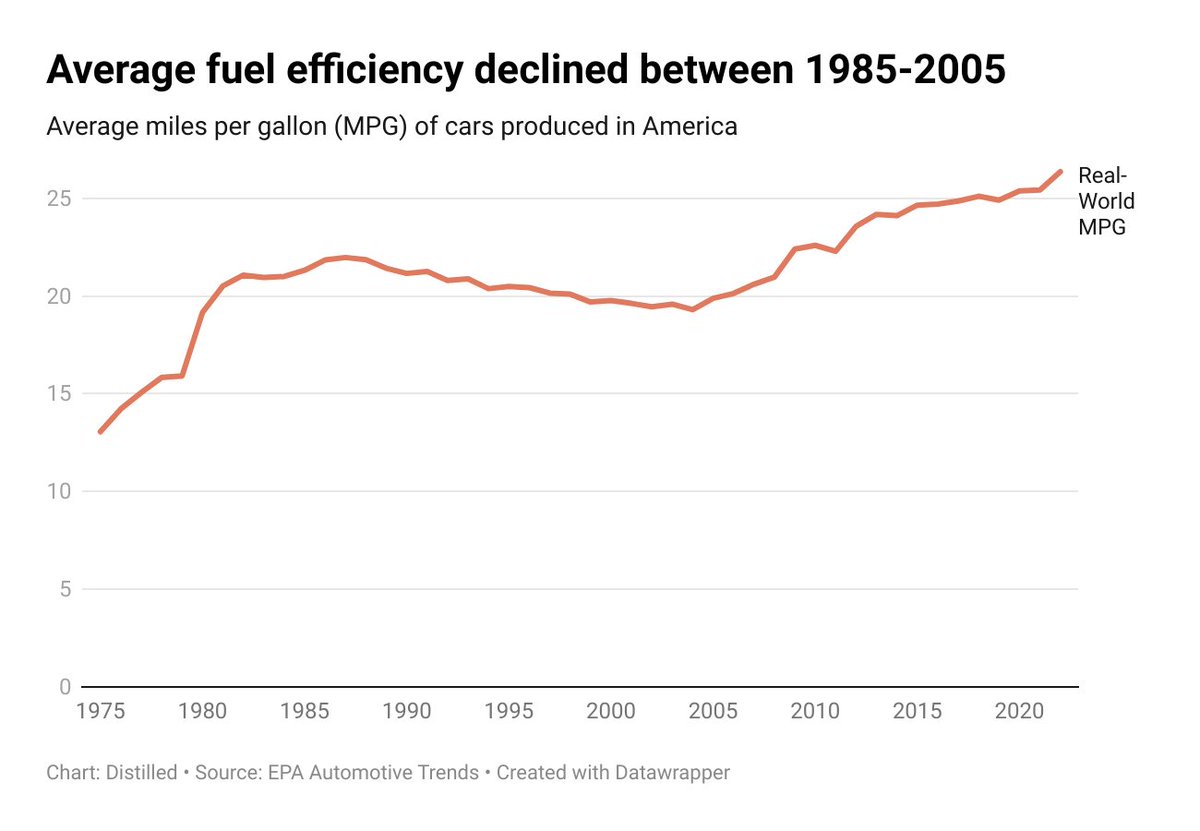In the last few decades, the SUV market in America has exploded.
Automakers say the reason for this growth has been "changing consumer preferences."
But that's not the full story.
One of the main reasons for the growth is the "SUV loophole."
🧵 https://t.co/JXeFEGn6k4

In 1975, Congress passed a law that forced automakers to double the average fuel efficiency of their vehicles to 27.5 miles per gallon by 1985.
But half a century later, the average vehicle produced in America still doesn’t get 27.5 MPG.
So what happened? https://t.co/sLzTLiRayR

The intent of that 1975 law was to make all passenger vehicles in America more fuel efficient.
But auto lobbyists convinced regulators to make a subtle change to the bill’s text.
https://www.distilled.earth/p/the-loophole-that-made-cars-in-america
While efficiency standards for cars would be written into the law itself, the standards for trucks were to be set by regulators at the Transportation Department.
Why? Because it would be easier for lobbyists to weaken the rules.
This proved to be a genius, if unethical, strategy.
Out of the public eye, lobbyists were able to significantly weaken pollution and safety standards on trucks.
Lobbyists also convinced regulators to define trucks as “an automobile capable of off-highway operation.”
Thus, as long as an SUV had four-wheel drive and decent ground clearance, it could avoid the more stringent car regulations and instead be regulated as a truck.
The SUV loophole significantly changed the economics of making cars in America.
Due to their more stringent regulations, small cars became more expensive to manufacture. Meanwhile, trucks and SUVs became cash cows.
https://www.distilled.earth/p/the-loophole-that-made-cars-in-america
In the 1990s, Ford launched its Expedition, a tank of a car that got 14 MPG, worse gas mileage than the average car got 20 years earlier.
Thanks to the SUV loophole, the Expedition was wildly profitable for Ford, earning the company $12,000 in profit per vehicle.
That decade the big three automakers all rushed to make more SUVs.
But they quickly ran into a problem: most people didn’t really need them.
Consumer surveys found that just a few percent of SUV owners ever took their car off-road.
When people did take their SUVs off-road it was likely to be on a paved dirt road.
“The only time those SUVs are going to be off-road is when they miss the driveway at 3 a.m,” J.C. Collins, a marketing executive at Ford, told Keith Bradsher in "High and Mighty."
So automakers spent huge amounts of money generating demand for their profitable new gas-guzzlers.
SUV advertising grew from $172M in 1990 to $1B in 2000.
That decade, automakers and dealers spent a combined $9B pushing SUVs on consumers.
It’s tempting to think that none of this really matters going forward.
After all, many of the world’s biggest automakers have announced plans to electrify their vehicles over the coming decades.
EVs, no matter their size, don't emit CO2 or pollution out of their tailpipes.
But to ignore the SUV loophole and the problem of oversized vehicles would be a major mistake even in the age of electrification.
That’s the argument I’ll make in the next installment of this story.
Stay tuned for Part 2.
https://www.distilled.earth/
If you want to share this story with a friend who isn't on Twitter, here's the link to the full story on my newsletter:
https://www.distilled.earth/p/the-loophole-that-made-cars-in-america
And if you want to support my work, you can become a paid subscriber to my newsletter here.
For $5 per month you can make these Twitter threads and articles possible.
https://www.distilled.earth/subscribe
